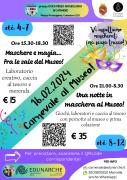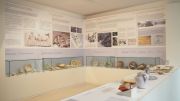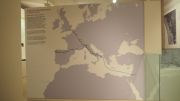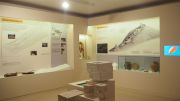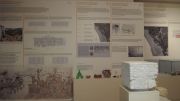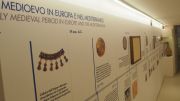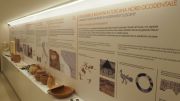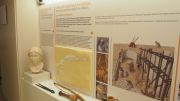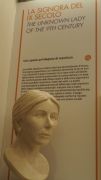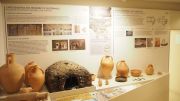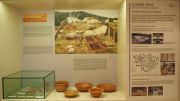A partire dalle ore 21 del 16 febbraio alle 8:30 del 17 febbraio l'associazione Ednuarche, in collaborazione con il Civico Museo Archeologico, organizza una notte in maschera al Museo, con giochi, attività laboratoriali e caccia al tesoro per bambini dagli 8 ai 12 anni, con pernotto al Museo e prima colazione inclusi.
Per info e prenotazioni contattare: 3203833252 (Marcella Parisi) o scrivere a: This email address is being protected from spambots. You need JavaScript enabled to view it.
This is the central court of the building; it is a space used for temporary exhibitions, conferences, presentations and educational activities.
This is the last room of the museum and represent the Renaissance phase of Camaiore, that was transformed from the fortified village of the 14th century, into a city in the 19th century.
During the Renaissance period numerous palaces are built and these ones substitutes the middle-age house-towers, while the village specializes in craft activities such as the production of Slipware, which is a kind of pottery identified by its decorating process, where slip is placed onto the clay body surface before firing by dipping, painting or splashing.
Palazzo Tori Massoni, which is the headquarter of this museum, was built in this period.
In this showcases are exposed numerous potteries founded in various buildings of the historic city center, from the archaic majolicas till the potteries of the late 18th century.
The activities linked to the exploitation of the mountainous areas, such as farming, chestnuts harvesting, cheese and butter working, wool, silk and hemp working for fabrics, and the use of mills and crushers along the river “Lombricese”.
The last part of this virtual journey through Camaiore’ s history concerns the passage from the illuminated writing to the invention of the Movable type in the 15th century.
It’s important to mention Ludovico Marracci, who was from Torcigliano (Camaiore).
He was a Professor Emeritus in the Roman Curia at Vatican, and author in the 17th century of the first translations of the Bible in Arabic and of the Quran in Latin.
The Late Middle Ages represent a period of huge scientific achievements, especially in Geography thanks to the trades with Arabic and eastern populations that had invented many instruments such as the astrolabe and the compass, and were experts in cartography.
Pisa is one of the most important trading centers with the other ones in the Mediterranean sea. This fact is highlighted by the numerous ceramic basins of Islamic origin, founded in Pisa and Lucca’ s churches.
Another important role was played by the great pilgrimage trails, that touch the most sacred places of Christianity, as Canterbury, Rome, Santiago de Compostela and Jerusalem.
Camaiore is also an important step of this path. In fact the Archbishop of Canterbury, Sigeric, describes this city in his diary during the return journey from Rome to the United Kingdom.
From the year one thousand in Versilia increases the number of sacral buildings and castles, that were the symbols of the local seigniories’ power, then absorbed by Lucca’ s territory, in the 13th century.
In particular, Montecastrese’ s castle was studied with several archaeological excavation campaigns, and also by a complex digital survey, thanks to a 3D Laser Scanner that allowed the creation of a reconstruction of the fortified top and the building’ s three-dimensional reconstruction.
This area is inhabited from the 3rd century B.C., while in the 10th century is a fortified castle and remain so till its destruction, after Lucca’ s conquest in 1223-1225.
From Montecastrese comes an important Byzantine icon, recovered by Pisa’ s soldiers that carried it into Pisa’ s cathedral, which is its current site. This is a reproduction of the icon, realized by a local school.
There are also: a fourteenth-century capital from Badia of Saint Peter in Camaiore; a decorative architectural element from Montebello’ s church, both in marble; a stone epigraph that illustrates the founding of Collegiata di Santa Maria Assunta, and the 3D reproduction of the capital from the church of San Martino in Gello (Camaiore), but the original one is exposed in Villa Guinigi Museum in Lucca.
Here there is the chronology of Early Middle Ages, where are highlighted the main events from 476 A.D. to the year one thousand. It refers particularly to the Mediterranean area and the birth of the Islamic civilization.
On the other side of the corridor, we can focus on what contemporary was happening in Northern Tuscany: there were the Lombards on the territory and at the same time the building of military castles on hills, then used as civic structures that tend to replace the cities, in the administration of the territory.
Thanks to the dedication of amanuenses monks and their careful and accurate transcription (whenever possible) we can read many ancient texts.
Here we can find a goose’ s feather, the lunellum (a crescent moon-shaped knife used to erase the letters) and the Roman reproduction of an illuminated manuscript.
In this phase, in our territory, increases the number of places of Christian worship in different shapes, as for example the pieve (a rural church with a baptistery, upon which other churches without baptisteries depended), the badia (an abbey) and the monastery (a building or complex of buildings comprising domestic quarters, workplaces of monks and the church).
In Camaiore, in Piazza Francigena was discovered a church of the end of the 9th century, that was on the side of the present church of Saint Michael, with a burial area all around that was used until the 14th century.
From the skull of one of this people, buried in the early medieval period, was obtained the face reproduction of a 40 years-old woman, probably of a high status as shown by the anthropological and nutritional analysis made on it.
Here is described a time of delicate change, from Late Antiquity to Middle age.
There are two main factors: firstly, the continue pressure of many populations along the borders of the Empire, secondly the diffusion of Christianity, which is progressively replacing many religions (particularly from the Edict of Constantine of 313 A.D.).
In this period begin to develop forms of religious architecture adequate to the new religion, so every previous building, ritual and iconography are reinterpreted in this way.
In Byzantine times the developments of mosaic technique create extraordinary examples of Sacred art, as we can see in this reproduction of a portion of a mosaic coming from the harbor of Classe, in Ravenna.
In Versilia, Acquarella’ s farm (Capezzano), is maintained as an olive oil productive center till the 6th century, as witnessed by potteries in “Terra sigillata” (the crystalline red shiny coating) from Africa, coins and glasses..







